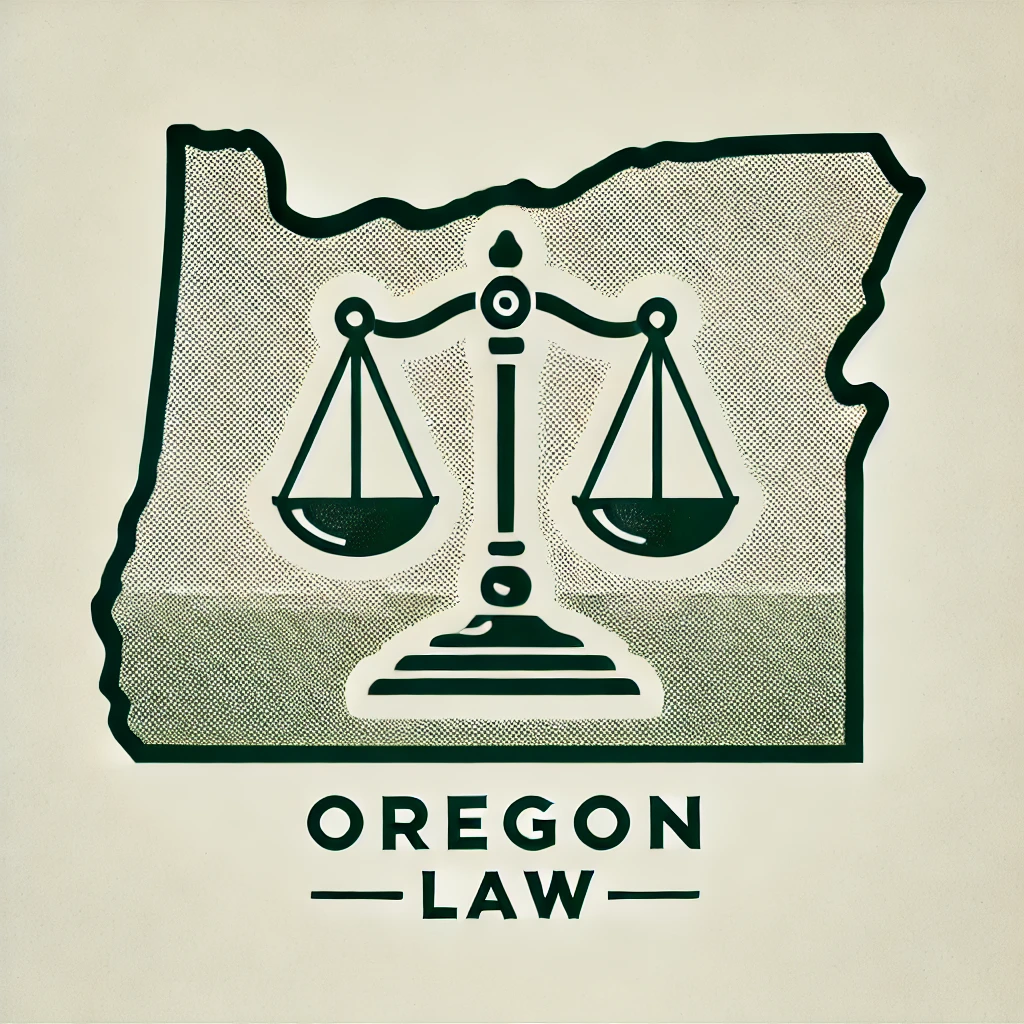What is a Law in Oregon?
Understanding what constitutes a law in Oregon is fundamental to navigating legal matters effectively. Laws in Oregon are established primarily through statutes and administrative rules, each serving a unique role within the legal system.
- Statutes (ORS): Laws enacted by the Oregon Legislature or through direct voter initiatives. They establish broad legal principles and frameworks that govern various aspects of life in Oregon, from criminal justice to civil rights and business regulations.
- Example: ORS 811.700 defines the offense of "Failure to perform the duties of a driver when property is damaged," commonly known as a "hit and run" involving property damage.
- Administrative Rules (OAR): Detailed regulations developed by state agencies to implement and interpret statutes. They provide specific guidelines and procedures to enforce statutes effectively.
- Example: OAR 847-010-0068 outlines the requirements for medical professionals regarding telemedicine practices in Oregon.
Oregon Revised Statutes (ORS)
How Laws are Codified
The codification process ensures that all laws are organized systematically within the Oregon Revised Statutes, making it easier for individuals, attorneys, and judges to locate and reference relevant laws.
- Legislative Sessions: Oregon's legislature meets annually, with longer sessions in odd-numbered years and shorter ones in even-numbered years.
- Enactment of Laws:
- Proposal: A legislator sponsors a bill, assigned a bill number (e.g., HB 2001 or SB 500).
- Committee Review: The bill is referred to a committee specializing in the bill's subject matter.
- Public Hearings: Stakeholders and citizens can testify in support or opposition to the bill.
- Amendments: The committee may amend the bill based on feedback and deliberations.
- Voting Process: If approved by the committee, the bill goes to the floor for debate and voting in its originating chamber, then moves to the other chamber for a similar process.
- Governor's Action: Upon passage by both chambers, the bill is sent to the governor, who can sign it into law, allow it to become law without a signature, or veto it.
- Publication: Enacted laws are assigned statute numbers and incorporated into the ORS by the Legislative Counsel Committee.
Key Examples of ORS
- ORS 20.080: Allows for the recovery of attorney fees in certain small tort claims, incentivizing fair settlement offers and making it feasible for individuals to pursue smaller claims.
- ORS 742.061: Pertains to insurance claims and the awarding of attorney fees when an insurer fails to settle a claim within six months of proof of loss, encouraging prompt and fair handling of insurance claims.
Oregon Administrative Rules (OAR)
Role and Authority of OAR
State agencies in Oregon are granted the authority to create administrative rules to effectively implement and enforce statutes.
- Statutory Authority: Each agency's rulemaking power is derived from specific statutes outlining the scope and limitations of their authority.
- Example: The Oregon Health Authority derives rulemaking authority from statutes related to public health, allowing it to establish regulations on matters like disease control and health facility standards.
Rulemaking Process
- Notice of Proposed Rulemaking:
- Agencies file a notice with the Secretary of State and provide public notice, often including publication in the Oregon Bulletin.
- The notice includes the proposed rule text, a statement of need, and the legal authority under which the rule is proposed.
- Public Comment Period:
- Agencies allow a period during which the public can submit written comments or attend public hearings to provide feedback.
- This participatory process ensures transparency and considers the perspectives of those who may be affected by the rules.
- Finalization and Filing:
- After reviewing comments, the agency may revise the proposed rules.
- Final rules are filed with the Secretary of State and become part of the OAR.
Enforcement
- Agencies are responsible for enforcing the rules they establish, which may include conducting inspections, issuing licenses or permits, and imposing penalties for non-compliance.
Differences Between ORS and OAR
Understanding the distinctions between statutes and administrative rules is crucial for effective legal navigation.
Comparative Analysis
| Aspect | Oregon Revised Statutes (ORS) | Oregon Administrative Rules (OAR) |
|---|---|---|
| Enactment Authority | Enacted by the Oregon Legislature or through voter initiatives (ballot measures). | Created by state agencies through a rulemaking process authorized by statutes. |
| Amendment Frequency | Typically amended during legislative sessions, which occur annually. | Can be amended more frequently as needed by agencies, following the administrative rulemaking process. |
| Public Participation | Public can participate through contacting legislators, public hearings, and voting on ballot measures. | Public can participate during the notice and comment period of the rulemaking process. |
| Legal Hierarchy | Higher authority; statutes override administrative rules if there is a conflict. | Must conform to statutes; cannot exceed the scope of the agency's statutory authority. |
| Enforcement Mechanism | Enforced through the judicial system; violations may result in civil or criminal penalties. | Enforced by the respective agency; may involve administrative penalties, fines, or other regulatory actions. |
Practical Implications
- Legal Challenges: If an administrative rule is believed to exceed the agency's authority or conflict with a statute, it can be challenged in court.
- Compliance for Individuals and Businesses: It's crucial to be aware of both statutes and administrative rules, as both have the force of law and non-compliance can result in penalties.
- Role in Legal Proceedings: Both statutes and administrative rules may be cited in legal proceedings, with statutes often providing the foundational legal framework and administrative rules offering detailed application.
Personal Injury Laws in Oregon
Personal injury law in Oregon encompasses various statutes and rules that govern how individuals can seek compensation for injuries caused by others.
Statute of Limitations
Understanding the time limits for filing a lawsuit is critical.
- General Personal Injury Claims (ORS 12.110):
- Time Limit: 2 years from the date of injury.
- Wrongful Death Claims (ORS 30.020):
- Time Limit: 3 years from the date of injury resulting in death, but not more than 3 years from the date of death.
- Product Liability (ORS 30.905):
- Time Limit: 2 years from the date the injury was discovered or should have been discovered, but no more than 10 years after the product was purchased.
- Exceptions:
- Discovery Rule: Applies when the injury is not immediately apparent.
- Tolling Provisions: The statute of limitations may be paused under certain circumstances, such as the injured party being a minor or mentally incapacitated.
Comparative Negligence
Oregon's comparative negligence system affects how damages are awarded.
- Modified Comparative Fault (51% Bar Rule):
- ORS 31.600: A plaintiff can recover damages if they are not more than 50% at fault.
- Damage Reduction: The total damages awarded are reduced by the plaintiff's percentage of fault.
- Example: If you are awarded $100,000 but found to be 30% at fault, you receive $70,000.
Joint and Several Liability
- Economic Damages (ORS 31.610):
- Defendants can be held jointly and severally liable for economic damages, meaning each defendant can be responsible for the entire amount of economic losses.
- Non-Economic Damages:
- Liability is several only, so each defendant is responsible only for their proportionate share of non-economic damages (e.g., pain and suffering).
Steps to File a Personal Injury Claim
A systematic approach increases the likelihood of a favorable outcome.
- Immediate Actions:
- Medical Care: Prioritize health; obtain immediate medical attention.
- Documentation: Keep records of all medical treatments and expenses.
- Preserve Evidence:
- Scene Evidence: Photograph the accident scene, injuries, and any property damage.
- Witnesses: Collect contact information of any witnesses.
- Report the Incident:
- Law Enforcement: File a police report if applicable.
- Employer Reports: In workplace injuries, report to your employer promptly.
- Consult an Attorney:
- Case Evaluation: An attorney can assess the merits of your case.
- Legal Strategy: Develop a plan tailored to your circumstances.
- Insurance Notification:
- Inform Insurers: Notify your insurance company, but avoid detailed statements without legal advice.
- Demand Letter:
- Outline Damages: Include medical expenses, lost wages, and other losses.
- Settlement Offer: Propose a fair compensation amount.
- Negotiations:
- Mediation: May involve alternative dispute resolution methods.
- Counteroffers: Be prepared for back-and-forth negotiations.
- Litigation:
- Filing a Lawsuit: If a settlement cannot be reached, your attorney will file a complaint in court.
- Discovery Phase: Both parties gather information through depositions, interrogatories, and document requests.
- Trial: Present your case before a judge or jury.
- Post-Trial Actions:
- Collections: Implement measures to collect the judgment awarded.
- Appeals: Either party may appeal the decision within a specified time frame.
Glossary of Common Legal Terms
Legal terms and definitions to aid understanding.
- Affidavit: A written statement confirmed by oath or affirmation for use as evidence in court.
- Complaint: The initial pleading filed by the plaintiff stating the claims against the defendant.
- Comparative Negligence: A legal doctrine allocating damages based on the degree of fault.
- Damages: Monetary compensation sought or awarded in a lawsuit.
- Defendant: The party against whom a lawsuit is filed.
- Deposition: Testimony of a witness taken under oath outside of court.
- Discovery: The pre-trial process where parties obtain evidence from each other.
- Liability: Legal responsibility for one's actions or omissions.
- Liability Insurance: Coverage that protects against claims alleging that one's negligence or inappropriate action resulted in bodily injury or property damage.
- Motion: A formal request made to a judge for an order or judgment.
- Negligence: Failure to exercise reasonable care, resulting in harm to another.
- Regulation: A rule issued by an administrative agency, based on statutes.
- Settlement: An agreement reached between parties to resolve a lawsuit without going to trial.
- Statute: A law enacted by a legislative body.
- Tort: A civil wrong causing harm or loss.
- Tortfeasor: A person or entity who commits a tort (civil wrong).
Accessing Oregon's Legal Resources
Providing practical guidance on accessing and navigating legal resources.
Navigating the ORS
- Structure: The ORS is divided into volumes, chapters, and sections.
- Chapters: Organized by subject matter (e.g., Chapter 163: Offenses Against Persons).
- Sections: Specific laws within a chapter (e.g., ORS 163.160: Assault in the fourth degree).
- Online Access:
- Official Website: Oregon Legislature's ORS Page
- Features:
- Search Function: Search by keyword or statute number.
- PDF Versions: Downloadable chapters for offline reference.
- Annotations: Includes legislative history and notes of decisions.
Navigating the OAR
- Organization:
- Divisions: Each agency's rules are divided into divisions based on topics.
- Rule Numbers: Reflect the agency, division, and specific rule (e.g., OAR 839-009-0210).
- Online Access:
- Official Website: Oregon Secretary of State's OAR Page
- Features:
- Rule Search: Find rules by agency, keyword, or rule number.
- Rulemaking Notices: Access current and archived notices of proposed rulemaking.
Tips for Effective Research
- Use Advanced Search Options: Narrow down results by date, exact phrases, or specific agencies.
- Stay Updated: Laws and rules can change; always check the most recent version.
- Consult Legal Professionals: For complex matters, seek advice from an attorney.
Navigating the complexities of Oregon's legal system requires an understanding of both the statutes enacted by the legislature and the administrative rules developed by state agencies. Whether you're dealing with a personal injury claim or seeking to comprehend the legal obligations that affect your daily life, this knowledge empowers you to make informed decisions.
By familiarizing yourself with the ORS and OAR, you can better understand your rights and responsibilities. Remember, legal matters can be intricate, and professional guidance is invaluable in ensuring your interests are protected.
Contact Us for Legal Assistance
At Johnson Law, we are committed to helping you navigate the legal system with confidence. Our experienced personal injury attorneys are dedicated to providing personalized, compassionate representation.
- Why Choose Johnson Law?
- Experienced and Aggressive: Decades of combined experience in Oregon personal injury law. Millions of dollars recorded for our clients.
- Client-Focused: We prioritize your needs and work tirelessly to achieve the best possible outcome.
- Results-Oriented: A proven track record of successful settlements and verdicts.
- Our Services Include:
- Free initial consultations.
- Comprehensive case evaluations.
- Representation in negotiations and court proceedings.
Don't delay—the sooner you reach out, the sooner we can begin working on your case. Let us help you navigate the complexities of Oregon law and secure the compensation you deserve.
We will review your case for free.
Pay us nothing unless we get you a better settlement.
We work on contingency.


